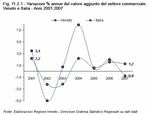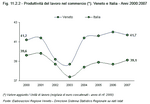A more detailed study of some economic variables shows that Veneto's distribution network is livelier than the national average as its value added by sector grew by 4.9% from 2001 to 2007
(Note 1) while average Italian growth was 1.0% over the same period.
In line with trends in the most modern economies, whose development of the tertiary sector can mainly be ascribed to an expansion of business services rather than to internal trade activity, the share of Veneto's value added in trade has slowly contracted since 2005, but it has always exceeded 10% and remained above the national level for the sector
(Figure 11.2.1).
The recovery of labour productivity is an objective which can also be found in the Lisbon Agenda and it is of great interest because it is usually one of the determinants of a country's improved output and economic development.
In the early 2000s, the patterns of national and regional trade both witnessed a slowdown in labour productivity, but since 2004 the trend has reversed and labour productivity has accelerated much more in Veneto than in the whole country on average. In four years, labour productivity increased by 2,000 euro per unit in Italy and by 3,000 euro per unit in Veneto, thus rising from 38,700 euro in 2003 to 41,700 euro in 2007. In 2007, labour productivity in trade was 41,700 euro per unit in Veneto compared to 39,100 euro in Italy. This is significant for the region in terms of competitiveness as growth in productivity goes hand in hand with an increase in wealth, as well as a strengthening of labour units in the sector.
In 2007, the total number of people working in the trade sector in Veneto was estimated to be 338,223 units, 51.4% of whom where employees. The aggregate figure has an annual variation of 0.7% for the total number of employed people and 2% for trade employees
(Figure 11.2.2).






